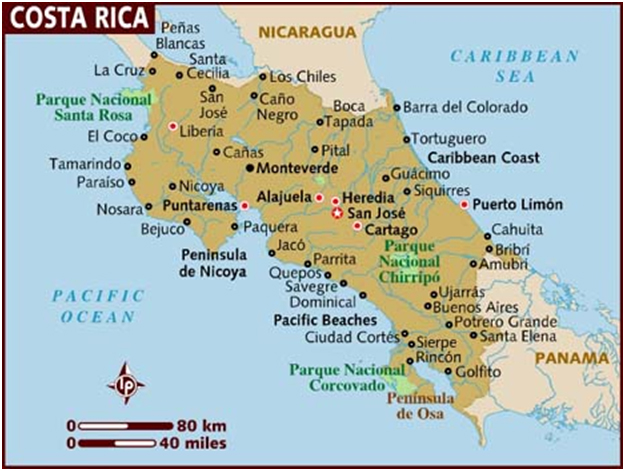Capital:
San Jose
Officially name in Spanish:
Republica de Costa Rica
Head of state: of government: President Laura CHINCHILLA Miranda
Languages: Spanish
Currency: Costa Rican colones (CRC)
Surface area: 51,100km2
Population: 4,695,942 (2013 est.)
Labour force: 2.196 million
GDP: US$58.6 billion (2012 est.)
GDP per capita: US$12,600 (2012 est.)
GDP Growth Rate: 4.8% (2012 est.)
Inflation: 4.5% (2012 est.)
Value of exports :
US$11.47 billion (2012 est.)
Main export commodities: bananas, pineapples, coffee, melons, ornamental plants, sugar; beef; seafood; electronic components, medical equipment
Exports of percentage of GDP:
32.20%
Largest companies: AETEC,
Afa Adquisition, Altor Electronica S.A,
Ameritex Centroamerica S.A., Ascende, Atlas
Electrica SA, BAC, Banco Internacional de
Costa Rica SA, Bandeco, Bodega Zeta Cuatro
S.A., Camtronics S.A., Casa de Medias Internacional
S.A., Centro Produccion Professional, Chez
Lui, CIA Odontologica S.A., Cibertec International,
Cibertel S.A., Coloplast, Comercializadora
Bticino, S.A,
Top business schools: Universidad de Costa
Rica,Universidad Nacional,Universidad Latina
de Costa Rica.
Literary rate: 94.9%
Human development index (2012):
0.773
Energy consumption (Quadrillion Btu):0.187
Energy production (Quadrillion Btu):0.087.
Sources of energy: hydroelectricity, geothermal
energy, solar and wind energy
(Source: CIA, The World Factbook)
|










